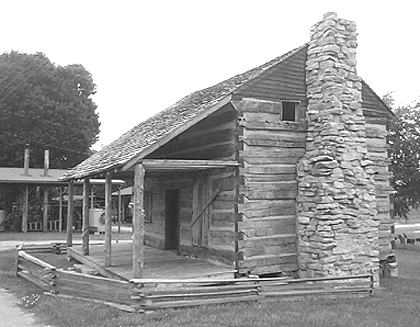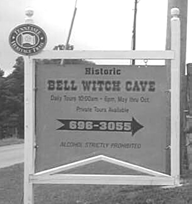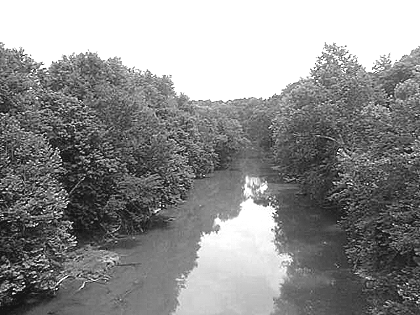The Bell Witch: The Full Account (46 page)

340 P A T
F I T Z H U G H
John Bell, Jr. 1793-1862 and his wife Elizabeth Gunn
Their children were
Sarah Williams, Joel Thomas, Zadok, Martha Miles,
Mary Allen and John
Joel Thomas Bell 1831-1910 and his wife Laura
Virginia Henry
Their children were
John Thomas, Flora Adeline, Sarah Elizabeth, Boyd
Minerva, Charles Bailey and Mary Allen
Inscription on the Bell monument at Bellwood
Cemetery.
About a quarter-mile west of Bellwood Cemetery is
the Bell School Antique Mall, located in the Bell
School building on Highway 41. Here, you will find
countless antiques – anything from churns to
furniture, and old books and postcards to authentic
soldier uniforms. Upstairs is where the “Bell Witch
THE BELL WITCH: THE FULL ACCOUNT
341
Opry” was held on Saturday nights for many years.
The Opry has since been moved to the old gym on
the first floor to provide access to handicapped
persons.
The antique mall is owned by James Humphries,
who possesses a wealth of knowledge about antiques
and the area’s history. On several different
occasions, Humphries has experienced strange and
unexplainable encounters while working at the
antique mall.
The old Bell School building is also home to the
Adams Museum and Archives. Dedicated on July 4,
1996, the museum boasts lots of documents,
pictures, and relics that pertain to the town’s past,
including a number of documents and pictures
pertaining to the Bell family. The museum’s curator,
Tim Henson, is very knowledgeable about the town’s
history and the legend of the “Bell Witch.” The
author feels that a trip to Adams is not complete
without visiting the Bell School Antique Mall and
museum, where one might run into Mr. Henson or
Mr. Humphries.
Owned by the City of Adams, the old Bell School
building was built in 1920 to replace another
building that was built in 1913 but burned in 1919.
The Bell School and was the only school in
northwestern Robertson County up until 1949, when
Jo Byrns School was built. Bell School remained
open as a junior high school up until 1975.

342 P A T
F I T Z H U G H
The Bell School Building in Adams, Tennessee.
Behind the old Bell School building stands an
authentic log cabin built in the early Nineteenth
Century, which acted as a tenant house on the Bell
farm for a number of years. After the deaths of his
parents, Joel Egbert Bell inherited the northwestern
portion of the Bell farm where the cabin was located.
Although it is fairly common knowledge that the logs
from the original Bell home were used to build
structures on Joel Bell’s land, the question of
whether any of these logs became a part of the
preserved log cabin remains unanswered.
The first answer one might arrive at is “no,”
because the cabin was built between 1810 and 1820,
many years before the original Bell home was razed
in 1843. By examining the situation more closely,
one will learn that the cabin’s additional half-story
was not added until many years after its original
construction. There exists the possibility that the
logs used to construct the second story were once a
part of the original Bell home.
In a report issued in January of 1996 by Steve
Rogers of the Tennessee Historical Commission, the
following observations of significance were noted:
THE BELL WITCH: THE FULL ACCOUNT
343
“…the Bell house is an early log structure. I
would guess the house was built between 1810-
1820…” “In fact, a portion of one of the cut joists
was used as chinking to fill a hole on the rear of
the house. This alteration may represent a major
remodeling of the structure, changing it from a
one story to a one and a half story house by
raising the walls and adding a stairs
and second
story floor.”
The land on which the log cabin was first situated
changed hands from Allen Bell to Levi Smith in the
1870’s. In 1941, Smith’s great-grandsons, George S.
and Theo Dickinson, Jr., also direct descendants of
James Johnston, acquired the land allowed the cabin
to be used as a tenant house up until 1966. mm The
cabin stood vacant until 1982, when Theo Dickerson,
Jr. donated it to the Tennessee-Kentucky
Threshermen’s Association, at which time it was
moved to its present-day location behind the old Bell
School building. 92
92 Information and report excerpts come from the memorandum,
The Bell Log House
, by Emerson A. Meggs, July 11, 1996.


344 P A T
F I T Z H U G H
The Bell Log Cabin, which is located behind the
Bell School building in Adams, Tennessee.
Just west of the old Bell School building on
Highway 41 is Keysburg Road, which leads to nearby
Keysburg, Kentucky. The
Bell Witch Cave is
approximately one mile
down this road from
Adams-proper. The cave
is currently open daily for
tours between May 1st and
October 31st, with only
weekend tours between
Labor Day and Halloween.
On the last few nights
leading up to Halloween,
the cave owners offer haunted hayrides, psychic
readings, books, and a full-service concession stand
in addition to tours of the cave. The cave is subject
to temporary closures due to floods or drought
conditions, so it is advisable to check before going. nn
THE BELL WITCH: THE FULL ACCOUNT
345
Two major events are held each year in Adams:
The Tennessee-Kentucky Threshermen’s Show and
the Bell Witch Bluegrass Festival.
Now in its 31st year, the Threshermen’s Show
boasts antique tractors and farm equipment, as well
as arts and crafts booths, tractor and mule pulls,
pony rides, square dances and other family activities.
This event is held every July on the grounds of the
old Bell School. The Bell Witch Bluegrass Festival,
now in its 22nd year, is the second oldest such
competition in Tennessee. Each year, bluegrass
musicians from all over the southeast converge on
the grounds of the Old Bell School to “pick and grin.”
Just as it was during the time of John Bell, the
Red River bottomland boasts large corn and tobacco
fields as far as the eye can see. During late summer,
the aroma of freshly cut tobacco being dried in the
area’s many tobacco barns fills the air. The terrain is
mostly flat, with dense forests covering the rolling
hills.
The Red River is much smaller now than it was in
the days of John Bell. Only small canoes and rafts
now use the river that once carried steamboats from
Port Royal to markets such as Natchez and New
Orleans. Despite the river’s many changes, the
magical melodies played by its ripples are as
delightful today as they were when Elizabeth Bell,
Joshua Gardner, and others walked its banks nearly
two centuries ago.

346 P A T
F I T Z H U G H
The Red River
THE BELL WITCH: THE FULL ACCOUNT
347
Appendix F:
The Primitive Baptists
T HE AUTHOR CANNOT OVER-EMPHASIZE
the importance of understanding the
religious beliefs and principles from which
many theological conflicts (discussed earlier) arose
during the John Bell era. Moreover, he feels this
discussion is warranted because it will help the
reader to better understand the profound social and
personal impact these conflicts had on those living in
the Red River community of Robertson County at the
time.
The author has provided the following discussion
of the Primitive Baptist faith because Red River
Baptist Church was closely aligned with its beliefs,
most notably Calvinism, during the time of John
Bell. Text from the London Baptist Convention of
1644, to which Red River Baptist Church subscribed,
and John Calvin’s doctrine of Predestination, are
presented in Appendices G and H, respectively.
Primitive Baptist ancestors have been called by
various names over the ages. The name
Primitive
Baptist
became popular in the early 1800’s, when the
term
primitive
conveyed the idea of originality rather
than backwardness.
Primitive Baptists claim the scriptures as their sole
rule of faith and practice, and therefore are not
bound to creeds of faith. However, churches and
associations among Primitive Baptists have
summarized their interpretation of scriptures in
various
Articles of Faith
. Primitive Baptists claim
348 P A T
F I T Z H U G H
primary descent from certain Baptist churches in
Wales and in the Midlands of England. The views of
these Baptists are summarized in the 1655 Midland
Confession of Faith. The Particular Baptists of
London are also part of Primitive Baptist heritage.
Their most important confessions of faith were the
London Confessions of 1644 and 1689. The 1644
confession better represents Primitive Baptist views
than the 1689 confession.
Primitive
also conveys the idea of simplicity. This